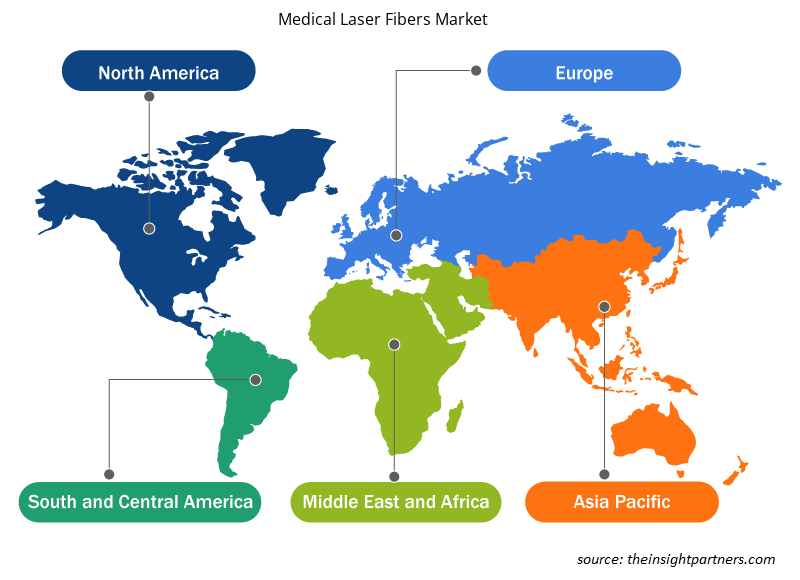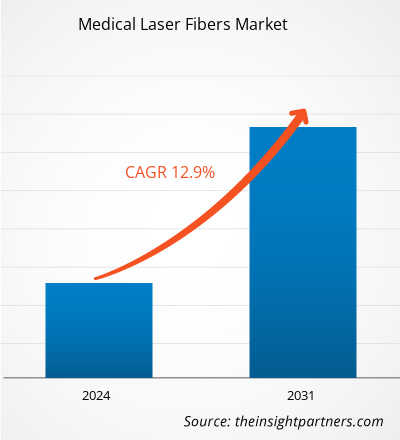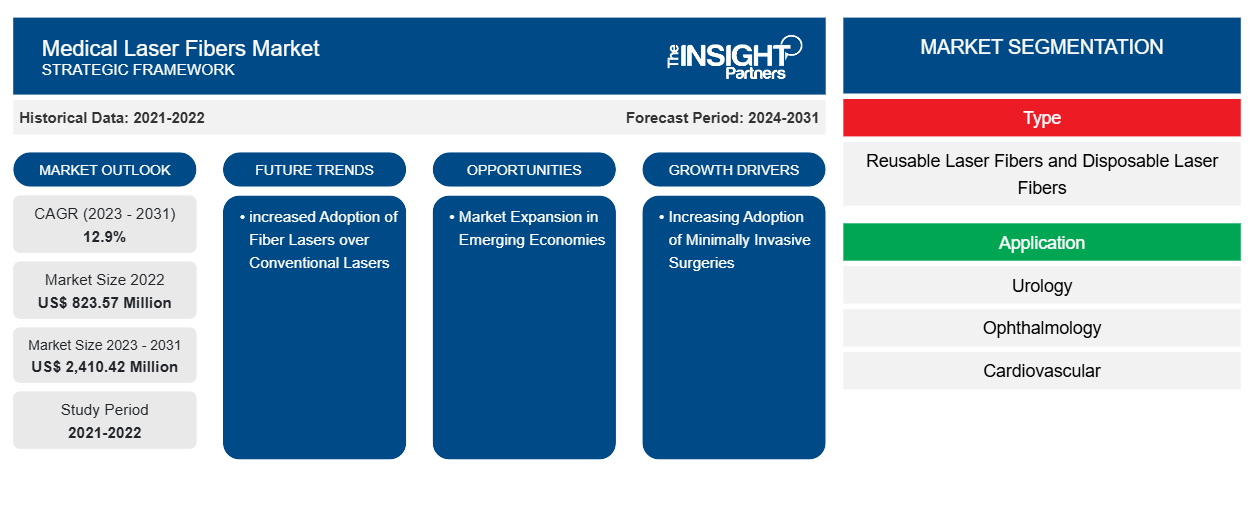Si prevede che la dimensione del mercato delle fibre laser mediche raggiungerà i 2.410,42 milioni di dollari entro il 2031, rispetto agli 823,57 milioni di dollari del 2022. Si prevede che il mercato registrerà un CAGR del 12,9% nel 2023-2031. È probabile che l'adozione crescente di fibre laser mediche avanzate rispetto ai laser convenzionali rimanga una delle tendenze chiave del mercato delle fibre laser mediche.
Analisi del mercato delle fibre laser mediche
Gli interventi chirurgici minimamente invasivi (MIS) continuano a essere una parte cruciale della chirurgia generale come opzione praticabile per la chirurgia aperta convenzionale e le tecniche laparoscopiche. Gli interventi chirurgici minimamente invasivi assistiti da laser stanno diventando uno standard in molteplici applicazioni poiché aiutano a ridurre la durata del recupero e a ridurre la morbilità. La medicina moderna aumenta l'uso dei laser per il trattamento di diverse patologie a causa del crescente interesse per le procedure minimamente invasive. I laser sono molto comunemente utilizzati nei campi della ginecologia, urologia , oftalmologia, odontoiatria, dermatologia e altri. Ad esempio, secondo un articolo pubblicato da myvision.org, la LASIK è una delle procedure oculari basate sul laser più comunemente eseguite negli Stati Uniti e nel 2022 saranno eseguite oltre 20 milioni di procedure LASIK. Inoltre, secondo l'American Society of Plastic Surgeons (ASPS), sono stati segnalati 1.798.253 casi di epilazione laser in tutto il mondo.
Panoramica del mercato delle fibre laser mediche
Le fibre laser mediche sono fibre specializzate progettate per fornire energia laser ai tessuti bersaglio con precisione, rendendole strumenti essenziali per procedure minimamente invasive nel settore sanitario. Queste fibre hanno ampie aree di applicazione come urologia, oftalmologia, dermatologia, gastroenterologia, oncologia e altre. La crescente prevalenza di disturbi cronici ha aumentato la domanda di interventi chirurgici minimamente invasivi, seguita dal progresso tecnologico nelle fibre laser mediche per ridurre gli effetti collaterali e aumentare l'efficienza del trattamento complessivo. Inoltre, si prevede che la crescente domanda di fibre laser mediche da parte delle economie in via di sviluppo insieme all'impennata dei lanci di prodotti creerà ampie opportunità durante il periodo di previsione. Tuttavia, si prevede che una maggiore adozione di fibre laser avanzate rispetto ai laser convenzionali guiderà la crescita del mercato.
Personalizza questo report in base alle tue esigenze
Riceverai la personalizzazione gratuita di qualsiasi report, comprese parti di questo report, o analisi a livello nazionale, pacchetto dati Excel, oltre a usufruire di grandi offerte e sconti per start-up e università
-
Scopri le principali tendenze di mercato in questo rapporto.Questo campione GRATUITO includerà analisi di dati che spaziano dalle tendenze di mercato alle stime e alle previsioni.
Driver e opportunità del mercato delle fibre laser mediche
Avanzamento tecnologico a favore del mercato
Con l'avanzare del campo della fotonica, i laser a fibra hanno continuato a essere la scelta preferita dai professionisti medici per molti usi, tra cui applicazioni diagnostiche e terapeutiche. Queste fibre sono state adottate rapidamente principalmente per le loro caratteristiche fisiche che consistono in una struttura di guida d'onda in fibra. Un'ampia varietà di lunghezze d'onda generate tramite laser a fibra, nonché la diversità di meccanismi fisici utilizzati nella generazione di impulsi, sostengono e integrano anche la flessibilità della tecnologia laser a fibra.
Gli operatori del mercato stanno lanciando sul mercato fibre laser medicali innovative che probabilmente ne stimoleranno l'adozione e aiuteranno la crescita del mercato globale delle fibre laser medicali. Ad esempio, nell'agosto 2023, InnoVoyce ha lanciato una nuova fibra da 300 micron progettata per offrire maggiore flessibilità e controllo durante le procedure di riparazione vocale. Con l'assistenza di un nuovo sistema di erogazione, i medici possono migliorare il controllo e la precisione necessari per indirizzare le aree di trattamento riducendo al minimo il rischio di danni ai tessuti circostanti.
Espansione del mercato nelle economie emergenti: un’opportunità per le fibre laser mediche
I mercati emergenti nei paesi in via di sviluppo stanno creando maggiori opportunità per i principali attori del mercato di espandere le proprie attività. La maggior parte dei principali attori si concentra sui mercati emergenti come Cina, India e altri. Poiché questi paesi hanno grandi popolazioni con enormi bacini di pazienti e un crescente progresso tecnologico insieme a nuovi lanci di prodotti, ci si aspetta che anticipino la crescita del mercato.
Inoltre, il crescente settore sanitario in queste regioni probabilmente migliorerà le prospettive di crescita per il mercato delle fibre laser mediche. Ad esempio, il crescente numero di ospedali aziendali come Apollo Group, Max, Fortis e altri in India probabilmente aumenterà la professionalità e porterà all'emergere delle ultime tecnologie mediche. Inoltre, anche i paesi del Golfo nella regione del Medio Oriente si stanno concentrando ampiamente sul miglioramento delle strutture sanitarie nella loro regione con investimenti sostanziali in tal senso. Ad esempio, il governo degli Emirati Arabi Uniti (EAU) sta aprendo politiche per ottenere investimenti esteri per migliorare lo standard sanitario e dare impulso al settore sanitario. Pertanto, si prevede che tutti i fattori sopra menzionati creeranno ampie opportunità per il mercato delle fibre laser mediche durante il periodo di previsione.
Analisi della segmentazione del rapporto di mercato sulle fibre laser mediche
I segmenti chiave che hanno contribuito alla derivazione dell'analisi di mercato delle fibre laser medicali sono tipologia e applicazione.
- In base al tipo, il mercato delle fibre laser mediche è suddiviso in fibre laser mediche riutilizzabili e fibre laser mediche monouso. Il segmento delle fibre laser riutilizzabili ha detenuto una quota di mercato maggiore nel 2023.
- Per applicazione, il mercato è segmentato in urologia, oftalmologia , cardiovascolare, respiratoria, neurologia e altre applicazioni. Il segmento urologico ha detenuto la quota maggiore del mercato nel 2023.
Analisi della quota di mercato delle fibre laser mediche per area geografica
L'ambito geografico del rapporto sul mercato delle fibre laser mediche è suddiviso principalmente in cinque regioni: Nord America, Asia Pacifico, Europa, Medio Oriente e Africa, e Sud e Centro America.
Il Nord America ha dominato il mercato delle fibre laser mediche a causa dell'aumento della domanda da parte della popolazione geriatrica in crescita che soffre di BPH, dell'aumento del numero di malattie croniche come malattie renali, malattie cardiovascolari e altre, e della presenza di attori chiave del mercato che offrono varie fibre laser. Inoltre, l'aumento dell'adozione del trattamento laser per l'estetica e l'oftalmologia nelle regioni stimolerà probabilmente la crescita del mercato delle fibre laser mediche nel Nord America. Si prevede che l'Asia Pacifica crescerà con il CAGR più elevato nei prossimi anni.
Approfondimenti regionali sul mercato delle fibre laser mediche
Le tendenze regionali e i fattori che influenzano il mercato delle fibre laser mediche durante il periodo di previsione sono stati ampiamente spiegati dagli analisti di Insight Partners. Questa sezione discute anche i segmenti e la geografia del mercato delle fibre laser mediche in Nord America, Europa, Asia Pacifico, Medio Oriente e Africa e America centrale e meridionale.

- Ottieni i dati specifici regionali per il mercato delle fibre laser mediche
Ambito del rapporto di mercato sulle fibre laser mediche
| Attributo del report | Dettagli |
|---|---|
| Dimensioni del mercato nel 2022 | 823,57 milioni di dollari USA |
| Dimensioni del mercato entro il 2031 | 2.410,42 milioni di dollari USA |
| CAGR globale (2023-2031) | 12,9% |
| Dati storici | 2021-2022 |
| Periodo di previsione | 2024-2031 |
| Segmenti coperti |
Per tipo
|
| Regioni e Paesi coperti |
America del Nord
|
| Leader di mercato e profili aziendali chiave |
|
Densità dei player del mercato delle fibre laser mediche: comprendere il suo impatto sulle dinamiche aziendali
Il mercato delle fibre laser mediche sta crescendo rapidamente, spinto dalla crescente domanda degli utenti finali dovuta a fattori quali l'evoluzione delle preferenze dei consumatori, i progressi tecnologici e una maggiore consapevolezza dei vantaggi del prodotto. Con l'aumento della domanda, le aziende stanno ampliando le loro offerte, innovando per soddisfare le esigenze dei consumatori e capitalizzando sulle tendenze emergenti, il che alimenta ulteriormente la crescita del mercato.
La densità degli operatori di mercato si riferisce alla distribuzione di aziende o società che operano in un particolare mercato o settore. Indica quanti concorrenti (operatori di mercato) sono presenti in un dato spazio di mercato in relazione alle sue dimensioni o al valore di mercato totale.
Le principali aziende che operano nel mercato delle fibre laser mediche sono:
- Tecnologie mediche Clarion
- Lumenis
- biolitec-srl
- BD
- Società scientifica di Boston
- Società Olimpo
Disclaimer : le aziende elencate sopra non sono classificate secondo un ordine particolare.

- Ottieni una panoramica dei principali attori del mercato delle fibre laser mediche
Notizie e sviluppi recenti sul mercato delle fibre laser mediche
Il mercato delle fibre laser mediche viene valutato raccogliendo dati qualitativi e quantitativi dopo la ricerca primaria e secondaria, che include importanti pubblicazioni aziendali, dati di associazioni e database. Di seguito è riportato un elenco degli sviluppi nel mercato delle fibre laser mediche:
- Rhein Laser Technologies Ltd. ha lanciato il sistema laser a fibra di tulio UroFiber SuperPulsed al MEDICA 2023 in Germania. Il sistema stabilisce un nuovo standard per le procedure urologiche come primo sistema laser a fibra di tulio (TFL) SuperPulsed da 1940 nm e 150 W al mondo per il trattamento perfetto sia della litotrissia dei calcoli che dell'enucleazione della BPH. (Fonte: Rhein Laser Technologies Ltd., Newsletter, 2023)
- Connet lancia il laser a fibra QCW ad alta potenza da 2 μm per applicazioni di litotripsia e chirurgia dei tessuti molli. Il laser a fibra QCW ad alta potenza da 2,0 μm di Connet può essere utilizzato nella ricerca scientifica, nell'elaborazione industriale e nelle applicazioni mediche. Il laser può essere utilizzato in particolar modo in alcune applicazioni chirurgiche come resezione, ablazione, vaporizzazione, coagulazione ed emostasi dei tessuti molli in urologia, litotripsia e chirurgia generale. (Fonte: Connet Laser Technology Co., Ltd., Comunicato stampa, 2023)
- Iridex Corporation ha lanciato sul mercato statunitense due nuovi laser di piattaforma di nuova generazione, Iridex 532 nm e Iridex 577 nm, in occasione dell'Hawaiian Eye and Retina 2024 Meeting. Entrambi i laser sfruttano più modalità di trattamento, tra cui onda continua e la tecnologia brevettata MicroPulse® di Iridex, e un'interfaccia touchscreen intuitiva che offre un'ampia gamma di opzioni e funzionalità di controllo clinico per ottimizzare il trattamento di disturbi della retina e glaucoma. (Eyes On Eyecare, Newsletter, 2024)
Copertura e risultati del rapporto sul mercato delle fibre laser mediche
Il rapporto "Dimensioni e previsioni del mercato delle fibre laser mediche (2021-2031)" fornisce un'analisi dettagliata del mercato che copre le seguenti aree:
- Dimensioni e previsioni del mercato a livello globale, regionale e nazionale per tutti i segmenti di mercato chiave coperti dall'ambito
- Dinamiche di mercato come fattori trainanti, vincoli e opportunità chiave
- Principali tendenze future
- Analisi PEST e SWOT dettagliate
- Analisi di mercato globale e regionale che copre le principali tendenze di mercato, i principali attori, le normative e gli sviluppi recenti del mercato
- Analisi del panorama industriale e della concorrenza che copre la concentrazione del mercato, l'analisi della mappa di calore, i principali attori e gli sviluppi recenti
- Profili aziendali dettagliati
- Analisi storica (2 anni), anno base, previsione (7 anni) con CAGR
- Analisi PEST e SWOT
- Valore/volume delle dimensioni del mercato - Globale, Regionale, Nazionale
- Industria e panorama competitivo
- Set di dati Excel
Report recenti
Rapporti correlati
Testimonianze
Motivo dell'acquisto
- Processo decisionale informato
- Comprensione delle dinamiche di mercato
- Analisi competitiva
- Analisi dei clienti
- Previsioni di mercato
- Mitigazione del rischio
- Pianificazione strategica
- Giustificazione degli investimenti
- Identificazione dei mercati emergenti
- Miglioramento delle strategie di marketing
- Aumento dell'efficienza operativa
- Allineamento alle tendenze normative























 Ottieni un campione gratuito per - Mercato delle fibre laser mediche
Ottieni un campione gratuito per - Mercato delle fibre laser mediche